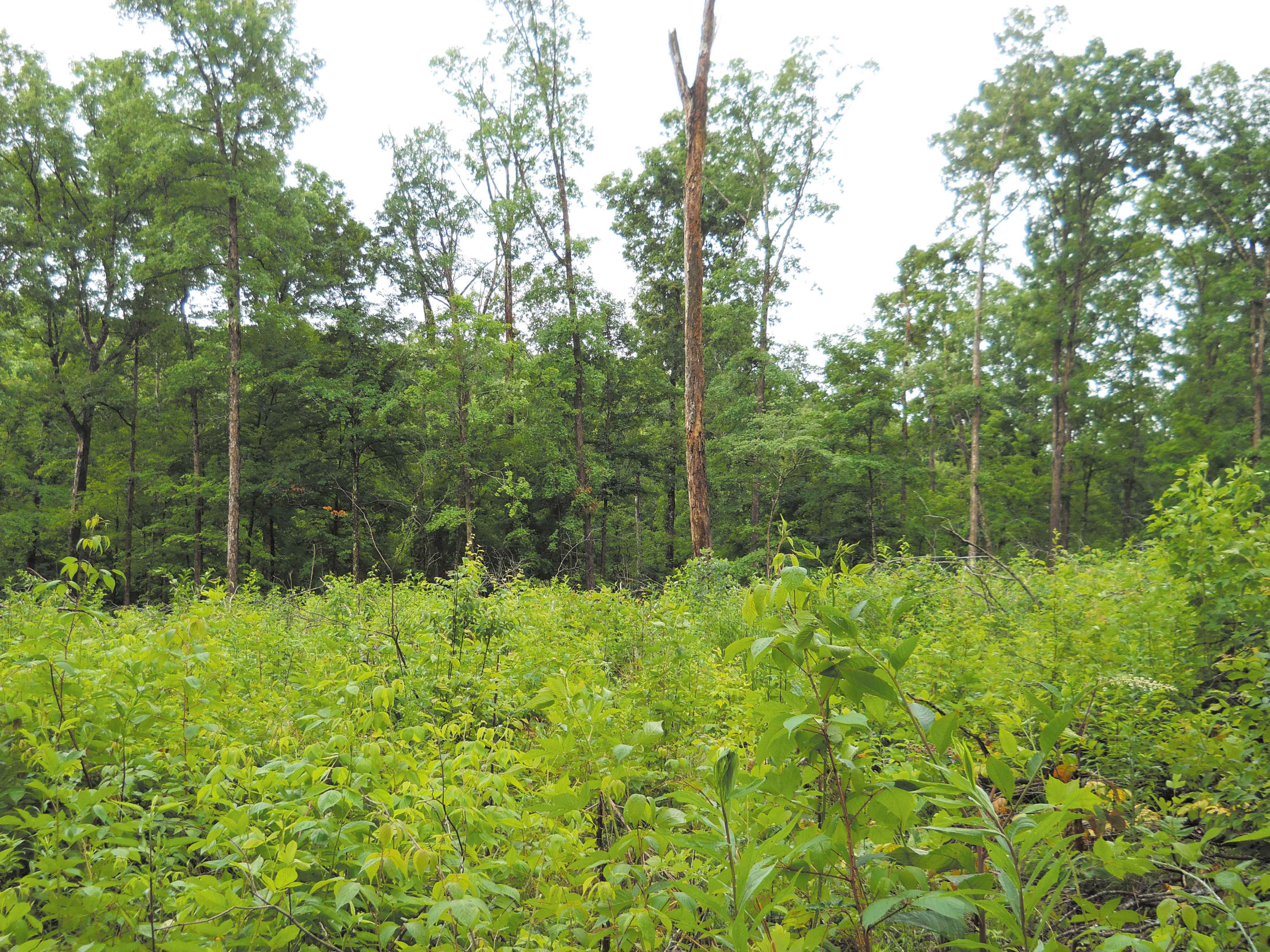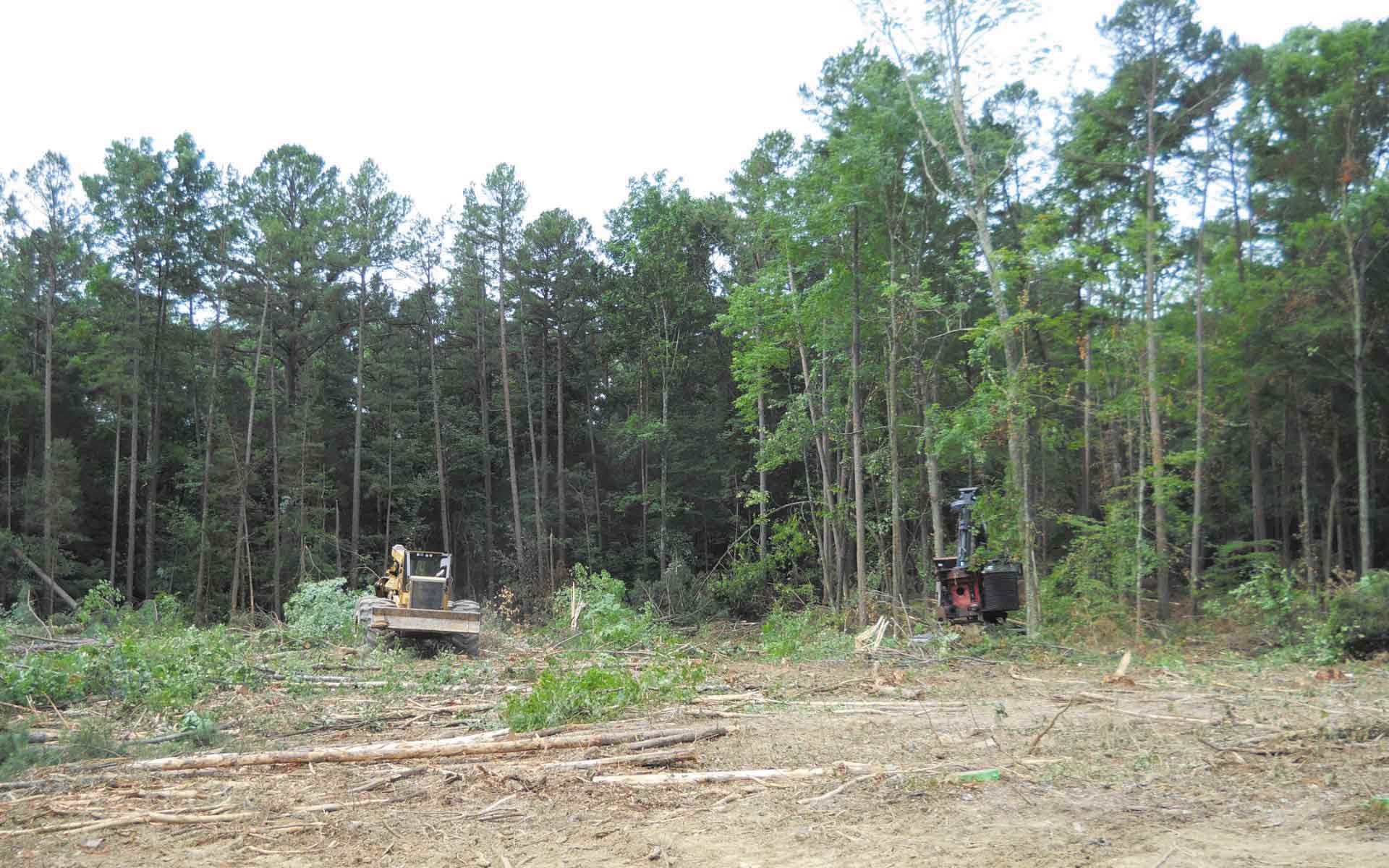Timber Sale Process on the Hoosier National Forest
Timber sale locations are determined by identifying where harvesting is needed as a tool to move the Forest toward the desired conditions described in the Hoosier National Forest (NF) Land and Resource Management Plan. Specialists such as wildlife biologists, soil scientists, and foresters meet as a team and look at large areas. Often these are watersheds or areas where the management objectives are similar. Figure 1. A hardwood group select area harvested in early 2016.
Figure 1. A hardwood group select area harvested in early 2016.
Once an area is approved by Forest leadership, data collection begins. Understory and overstory tree data is taken using both variable and fixed radius plots. This data, along with project objectives and ecological site capabilities are used to develop the proposed harvest areas and the silvicultural system that could be used.
When a proposal is completed, the National Environmental Policy Act (NEPA) process officially begins and one or more alternative actions are developed to achieve the purpose of the project. These alternatives are vetted with Forest staff and the public and then further refined, including measures to mitigate any anticipated undesirable effects.
Specialists, including biologists, archeologists, recreation specialists and others, then each write reports discussing the effects the timber sale would have on their resource. Information from these reports is rolled up into the decision document. At this point, the deciding officer chooses one of the alternatives, which authorizes the timber to be prepared for harvest in those areas. At this time, detailed prescriptions are written and “on the ground” implementation begins.
A large proposal will have multiple years of timber sales associated with it. Foresters try to design units of a sale in close proximity. After unit boundaries are designated, recon plots of the sale are taken. The Forest Service does not guarantee volume. However, we have policy that dictates the sampling error standards for expected timber sale advertised values. For example, it is Forest Service policy that sales with estimated values above $120,000 must have a sampling error of +10%. The recon plots are used to design a statistically defensible, efficient cruise. Figure 2. A pine clearcut being harvested, June 2017.
Figure 2. A pine clearcut being harvested, June 2017.
Sale prep personnel go through a certification training and field evaluation to ensure they meet standards for cruising fundamentals and continued satisfactory cruising performance. Trees in hardwood or pine thinnings are individually marked by the cruiser using a special paint used only for tree designation. This paint contains a tracer element as a timber theft deterrent. The cruise method in marked units is via 3P. In 3P, every tree is given a predicted volume estimate. A percentage of these trees are measured to calculate the measured to predicted volume ratio. This ratio is used to calculate the sale volume. Volume estimation in pine clearcuts is accomplished by fixed or variable radius plots.
One of the biggest differences in Forest Service contracts is the unit of volume measurement. Nationally, Forest Service tree measurement sales are sold by cubic foot volume. Our standard unit of measurement is 100 cubic feet, or 1 CCF. The Hoosier NF uses a conversion factor for sawtimber volumes of 1 CCF = 600 board feet on the International 1/4 inch rule. At this conversion rate, an advertised sale of 2,000 CCF would be 1.2 MMBF, International 1/4. Current sales under contract vary from 164 to 5,688 CCF.
Once volume estimation is complete, the timber is appraised, taking into consideration required contractual costs such as roadwork on Forest Service roads, required equipment cleaning of off-road equipment for invasive species, as well as logging and hauling costs. The contract is drafted with the specific sale information, such as location, volumes and contract term. Additionally, specific provisions for contractual areas like resource protection, payments, road maintenance and fire precautions are included.
Bid packages are sent to individuals and companies that have expressed an interest in receiving notice of Forest Service timber sales. Notices are posted in the local newspaper and on the Hoosier NF webpage. Sales are open for bid for a minimum of 30 days. The advertised value is the minimum price at which the timber will be sold.
Sealed bids may be turned in at any time prior to the bid opening. At bid opening the bidder with the highest bid is determined to be the apparent high bidder. The timber sale Contracting Officer must make an affirmative determination of the high bidder’s responsibility, which includes having the financial and physical means to harvest timber, having a satisfactory performance record on previous timber sale contracts, and a satisfactory record of business ethics. Once this review is complete, the contract is awarded.
For standard timber sales, the high-bidder process previously described is used. The awarding of stewardship contracts is different. Stewardship contracts contain timber removal as well as land management activities. Potential bidders bid on rates for timber, as well as their rates for land management activities. Accomplishment of land management work in the contract builds credit for the timber purchaser that can be used to pay for timber removal. In these bid packages, potential bidders turn in a technical proposal. The bidder determined by an evaluation panel to be the best value to the government is awarded the contract.
After contract award, the timber purchaser must make a downpayment of 10% of the advertised value, plus 20% of the bid premium. A performance bond of 10% of the sale value is required. The downpayment is frozen until 25% of the sale value is cut, at which point it is released back to the purchaser. Rather than pay the entire value of a multi-unit sale up front, the timber purchaser only pays for the individual units in the sale as they harvest them. Additionally, the purchaser maintains extra money on account for additional volume for skid trails, landings, etc. Payments can be in the form of cash, or guarantees such as letters of credit or bonds.
During the life of the sale, the Forest Service makes frequent inspections to check for contract compliance and routine sale administration tasks such as agreements on the location of skid trails. Additionally they work with resource specialists such as biologists or recreation specialists for resource protection needs.
Direction for the federal timber sale process comes from laws passed by Congress, local and national Forest Service policy, and the NEPA document. The timber sale is a tool that allows us to meet restoration goals on the Forest, while supporting local jobs and economies with sustainably harvested forest products.
Andrea Crain has been a public affairs officer for the Hoosier National Forest since 2016. She is responsible for outreach and information services, media contacts, legislative issues, and conservation education.
